For medical device companies, obtaining FDA clearance through the 510(k) pathway is a critical milestone on the journey to market. However, the process can be complex, time-consuming, and fraught with potential pitfalls that can delay your product launch by months or even longer.
At The FDA Group, our team of regulatory experts has helped countless medical device manufacturers navigate the 510(k) submission process successfully. Drawing from our extensive experience, we've compiled these ten essential tips to help you optimize your 510(k) submission strategy and increase your chances of a smooth, delay-free review.
Our consultants have generously shared their insights, tips, and practical advice to help you understand the key requirements, avoid common oversights, and maximize your chances of success. This guide is essential for medical device manufacturers looking to navigate the premarket notification process confidently.
Read our companion guide for a deeper dive into the 20 components of a 510(k) submission document, specifically.
Need expert help navigating the premarket notification process? Learn more about our 510(k) consulting services and contact us today to rapidly access the industry’s top regulatory talent.
FREE CASE STUDY
Guiding 510(k) Preparation and Submission for U.S. Medical Device Market Clearance
Learn how The FDA Group supported a biomedical sensor company’s FDA premarket notification by redirecting its regulatory strategy to the optimal 510(k) program, providing expert guidance to a small in-house regulatory team, and engaging with regulators.
1. Master Your Predicate Device Selection
The foundation of every successful 510(k) submission lies in selecting the appropriate predicate device. Remember that substantial equivalence is based primarily on two key factors:
- Intended use: How the device will be used in clinical practice
- Technological aspects: The design, materials, and operating principles.
When selecting your predicate device, thoroughly understand your intended claims and carefully study your competitors.
|
Ask yourself:
|
Don't limit your research to marketing materials alone. Take the time to review previous submissions for your intended predicate by examining 510(k) summaries posted by FDA, 510(k) Statements (which can be requested), information available through FOIA requests, and FDA reviewer notes.
Whenever possible, we suggest obtaining samples of potential predicate devices for side-by-side testing with your product. This direct comparison can provide extremely data for your submission.
2. Consider Using Reference Devices
Sometimes, your device may have significant technological differences from available predicates. If so, consider including reference devices in your submission, particularly when:
|
3. Plan to Engage with the FDA Early Through Pre-Submissions
The pre-submission process (or "pre-sub") offers an invaluable—and surprisingly underutilized—opportunity to receive FDA feedback before committing to your full submission strategy.
Always initiate a pre-sub, especially when:
|
Early interaction with FDA reviewers can help identify potential issues before they become roadblocks, align expectations, and possibly streamline the formal review process later.
4. Explore Special Designation Programs When Applicable
For qualifying devices, the FDA offers accelerated pathways that can expedite the review process.
|
The Breakthrough Devices Program is appropriate if your device:
|
|
The Safety and Performance Based Pathway (STeP) may be suitable if your device:
|
These programs can provide increased opportunities for FDA interaction and potentially faster reviews.
5. Conduct Thorough Testing and Present Data Effectively
Comprehensive performance testing is essential for demonstrating substantial equivalence.
|
Make sure your testing:
|
When presenting test data in your submission, always make sure to include clear summaries explaining why the results are relevant to safety and effectiveness. Use tables, flowcharts, and illustrations to make complex information easily digestible for reviewers.
6. Pay Attention to Submission Logistics
The technical content of your submission is crucial, but don't overlook the logistical elements that can impact review efficiency:
|
A well-organized submission demonstrates professionalism and respect for reviewers' time, potentially facilitating a smoother review process.
7. Anticipate and Address Potential Questions
Put yourself in the reviewer's position and anticipate questions or concerns they might have about your device or testing approach. Proactively addressing these points in your submission can prevent delays associated with additional information requests.
For each claim or statement, ask yourself:
|
8. Develop a Comprehensive Regulatory Strategy
Your 510(k) submission should be part of a broader regulatory strategy that considers:
|
This strategic approach ensures your submission aligns with long-term business objectives and prepares you for regulatory obligations beyond initial clearance.
9. Build a Strong Regulatory Team
Whether in-house or through consultants, ensure your regulatory team has:
|
The right expertise can make the difference between a straightforward review and a prolonged, challenging process.
10. Learn from Every Interaction with the FDA
Each submission and FDA interaction provides valuable insights for future regulatory efforts:
|
This continuous learning approach helps refine your regulatory strategy over time and builds institutional knowledge that benefits all future submissions.
Need Expert 510(k) Guidance? Let's Talk.
The FDA Group offers comprehensive 510(k) consulting services led by experienced regulatory professionals, many of whom are former FDA personnel. Our team provides:
- Regulatory strategy development
- Preparation of 510(k) submissions
- Review and analysis of device and predicate relationships
- FDA interaction management
- Support throughout the review process
- Post-clearance regulatory support
A flawed submission can delay your product launch by months or longer. Our 510(k) consultants provide individualized support to maximize the likelihood of a successful, delay-free submission process. With a 95% success rate (right resource, first time) and 97% client satisfaction rate, we deliver better talent, faster and more cost-effectively than traditional consulting firms.
An Expert Guide to FDA 510(k) Submissions
Download our free white paper and get the best practices you need to successfully navigate the premarket notification process.

PreparationSubmission-Cover.webp?width=267&height=348&name=fda-CaseStudy-Guiding510(k)PreparationSubmission-Cover.webp)



